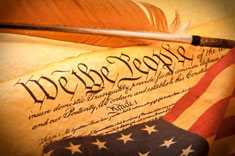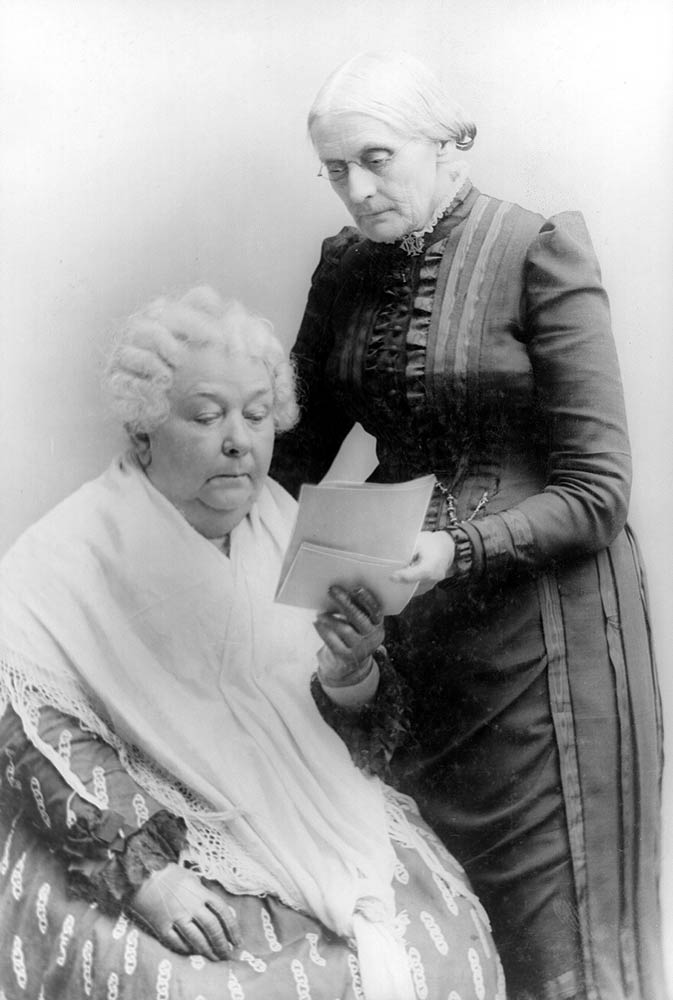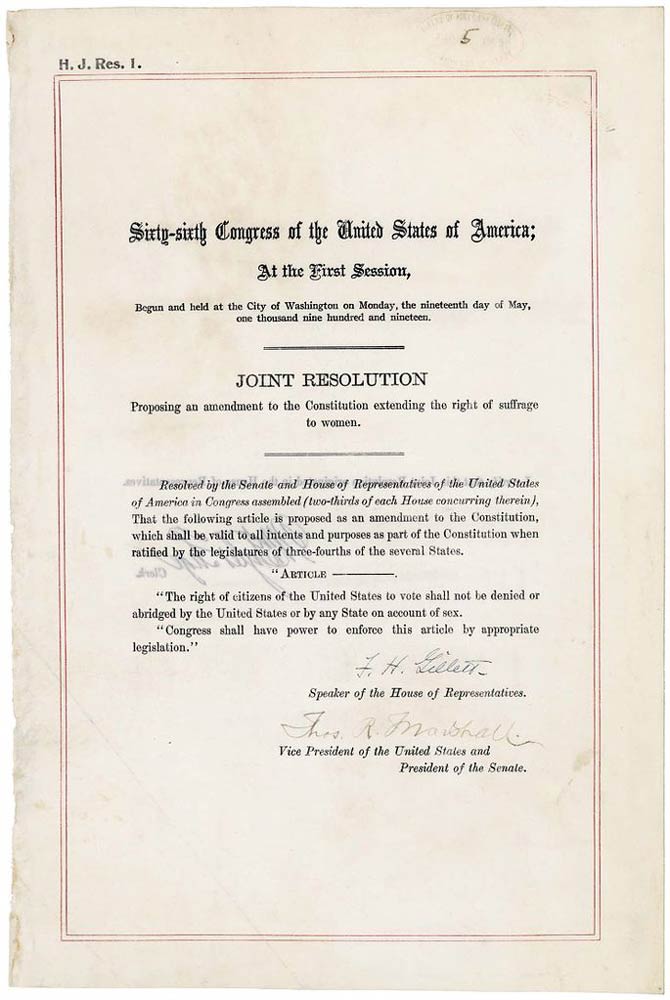| United States Constitution | |
|---|---|
 |
|
| The U.S. Constitution | |
| Preamble | |
| Articles of the Constitution | |
| I ‣ II ‣ III ‣ IV ‣ V ‣ VI ‣ VII | |
| Amendments to the Constitution | |
| Bill of Rights | |
| I ‣ II ‣ III ‣ IV ‣ V ‣ VI ‣ VII ‣ VIII ‣ IX ‣ X | |
| Additional Amendments | |
| XI ‣ XII ‣ XIII ‣ XIV ‣ XV ‣ XVI ‣ XVII ‣ XVIII ‣ XIX ‣ XX ‣ XXI ‣ XXII ‣ XXIII ‣ XXIV ‣ XXV ‣ XXVI ‣ XXVII | |
| View the Full Text | |
| Original Constitution | |
| Bill of Rights | |
| Additional Amendments |
On June 4th, 1919, the United States Constitution saw a radical change. During that year Congress passed the amendment that granted women the right to vote. For over one hundred years, women and those that sympathized with the suffrage movement had been fighting for change that would give everyone a say in how the United States was governed.
For decades, women’s rights leaders traveled the country giving speeches, organizing protests and writing articles that would garner support for their cause. Their hard work paid off. Unfortunately, many of the women who were instrumental in getting the amendment passed were not alive to see their life long goals come to fruition.
Text
The right of citizens of the United States to vote shall not be denied or abridged by the United States or by any State on account of sex.
Congress shall have power to enforce this article by appropriate legislation.
Background
The mid-19th century saw the beginning of the women’s’ suffrage movement. Within a few decades, major women’s organizations such as the National Woman Suffrage Association and the American Woman Suffrage Association began forging their fight to earn women the right to vote. The most notable leaders, Susan B. Anthony and Elizabeth Cady Stanton, led scores of women and other supporters in public rallies and sit-ins.
 They began the fight by challenging the fourteenth and fifteenth amendment in the case known as the New Departure Strategy. Their argument was that the fourteenth and fifteenth amendment automatically included women in its verbiage as having the right to vote. The court case was unsuccessful however, and the Supreme Court rejected the argument. After years losing court cases, it was clear that the suffrage movement needed to try a different angle. By 1875, the focus shifted to a new fight – amending the constitution with the hopes of gaining equal rights in that way.
They began the fight by challenging the fourteenth and fifteenth amendment in the case known as the New Departure Strategy. Their argument was that the fourteenth and fifteenth amendment automatically included women in its verbiage as having the right to vote. The court case was unsuccessful however, and the Supreme Court rejected the argument. After years losing court cases, it was clear that the suffrage movement needed to try a different angle. By 1875, the focus shifted to a new fight – amending the constitution with the hopes of gaining equal rights in that way.
The years that followed saw Elizabeth Cady Stanton and Susan B Anthony gain even greater notoriety as they worked tirelessly to draft an amendment to the constitution that would be later introduced in the Senate in 1878. With the help of a few senators and other women supporters the bill was introduced and many women testified before the senate in support of the amendment. After years of not being considered, the amendment was considered, but rejected by the Senate and the suffrage movement forged on to continue the fight.
Women around the United States began fighting smaller battles trying to gain partial suffrage rights in individual states. Women’s organizations began gaining momentum by aiming for voting rights in state and local elections. The year 1910 saw some success, with Wisconsin and California giving women the right to vote. The years that followed proved promising as many states on the West coast began to pass their own laws giving women the right to vote  in state elections. In 1912, the election of Democratic President Woodrow Wilson gave the suffrage movement another boost and the amendment drafted by Susan B. Anthony was again brought before the Senate. It was rejected, but the next several years saw a flurry of activity. It wasn’t until June 4th, 1919 that the 19th amendment was passed in the House and Senate giving women the right to vote.
in state elections. In 1912, the election of Democratic President Woodrow Wilson gave the suffrage movement another boost and the amendment drafted by Susan B. Anthony was again brought before the Senate. It was rejected, but the next several years saw a flurry of activity. It wasn’t until June 4th, 1919 that the 19th amendment was passed in the House and Senate giving women the right to vote.
Ratification
The 19th amendment was passed in 1919 allowing women the right to vote in national elections. It was not until August 18th, 1920, however, that the 36th state of Tennessee ratified the amendment. Three-fourths of the states had ratified the amendment and that gave it the power needed to be ratified to the United States Constitution.
There were a few challenges to the amendment as a few states were very reluctant to uphold the amendment citing its validity as the reason. The case of Leser v. Garnet brought this reluctance to light as two women were being sued for attempting to vote in Baltimore, Maryland. The suit was rejected and the women were allowed to vote, thus proving that the hard work and dedication of the many women’s rights groups had paid off.
The fight for women’s suffrage was one that spanned the course of over 100 years. The passing of the 19th amendment was the result of years of riots, lectures and marches by women and men that wished to see every American afforded the right to participate in the American democratic process. After years of being rejected in the either the House or Senate, the 19th amendment was etched into the American Constitution and forever transformed the way in which politics was run in the United States.